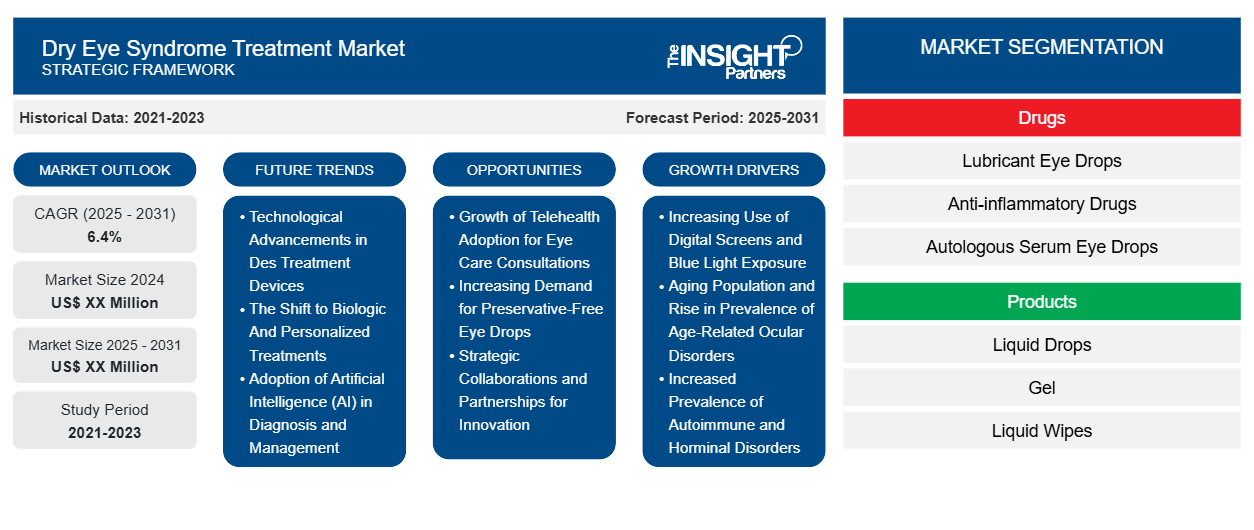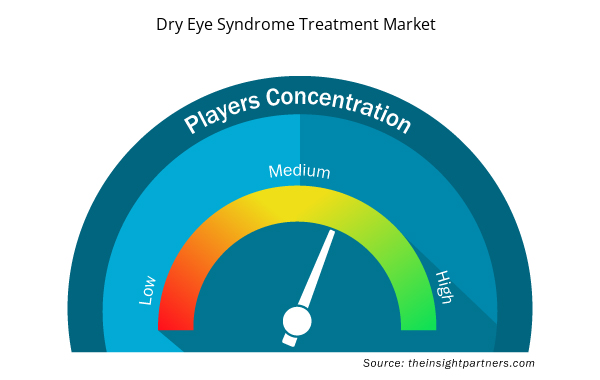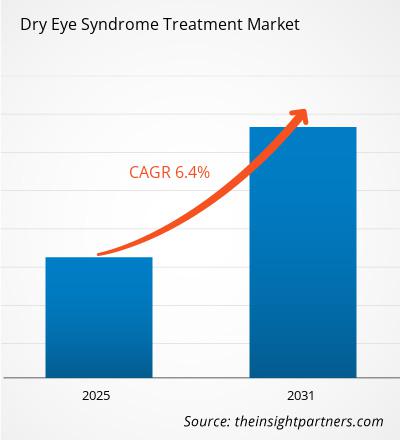The Dry Eye Syndrome Treatment Market is expected to register a CAGR of 6.4% from 2025 to 2031, with a market size expanding from US$ XX Million in 2024 to US$ XX Million by 2031.
The research report is segmented by drugs into Lubricant Eye Drops, Anti-inflammatory Drugs, Autologous Serum Eye Drops. Products analyzed include Liquid Drops, Gel, Liquid Wipes, Eye Ointment. The global analysis is broken down by region and key countries, covering North America, Europe, Asia Pacific, the Middle East and Africa, and South America. The market evaluation is presented in US$ for all segmental analyses.
Purpose of the Report
The report Dry Eye Syndrome Treatment Market by The Insight Partners aims to describe the present landscape and future growth, top driving factors, challenges, and opportunities. This will provide insights to various business stakeholders, such as:
- Technology Providers/Manufacturers: To understand the evolving market dynamics and know the potential growth opportunities, enabling them to make informed strategic decisions.
- Investors: To conduct a comprehensive trend analysis regarding the market growth rate, market financial projections, and opportunities that exist across the value chain.
- Regulatory bodies: To regulate policies and police activities in the market with the aim of minimizing abuse, preserving investor trust and confidence, and upholding the integrity and stability of the market.
Dry Eye Syndrome Treatment Market Segmentation
Drugs
- Lubricant Eye Drops
- Anti-inflammatory Drugs
- Autologous Serum Eye Drops
Products
- Liquid Drops
- Gel
- Liquid Wipes
- Eye Ointment
Customize This Report To Suit Your Requirement
You will get customization on any report - free of charge - including parts of this report, or country-level analysis, Excel Data pack, as well as avail great offers and discounts for start-ups & universities
Dry Eye Syndrome Treatment Market: Strategic Insights

- Get Top Key Market Trends of this report.This FREE sample will include data analysis, ranging from market trends to estimates and forecasts.
Dry Eye Syndrome Treatment Market Growth Drivers
- Increasing Use of Digital Screens and Blue Light Exposure: One of the major factors driving this market is extended screen exposure. With digitalization at workplaces on the rise, along with smartphone, tablet, and computer use, people are exposed to digital screens for longer periods. Almost 60% of office workers in most parts of the world complain of digital eye strain in various studies, which always precedes DES. The blue light emitted from these devices further accentuates symptoms by destabilizing the tear film and increasing oxidative stress on the ocular surface. Recent developments have introduced eye lubricants specifically for digital users, aiming to remedy tear film instability. Besides this, awareness of screen breaks and protection with blue light-blocking eyewear is gaining momentum. With the rising trend of working from home, this demand for DES treatments will increase further, thus offering significant growth opportunities to the manufacturers of pharmaceuticals and eye care products.
- Aging Population and Rise in Prevalence of Age-Related Ocular Disorders: A very critical driver in the dry eye syndrome treatment market is the rise in the aging population globally. According to the United Nations, by 2050, the number of people aged 65 and over will increase twofold, reaching 1.5 billion. With aging, there is a natural reduction in tear production, thus predisposing the elderly to symptoms of dry eye. Furthermore, with age-related disorders, such as dysfunction of the meibomian glands, which affect the composition of tears, the symptoms of DES worsen. According to the National Eye Institute, about 75% of people over age 60 have some symptoms of dry eye. As such, pharmaceutical companies are also meeting this shifting demographic with new prescription eye drops and other minimally invasive procedures that address DES symptoms. The geriatric population is more likely to present for regular consultations in eye care, thereby increasing the demand for diagnosis and therapeutic solutions. This, therefore, creates a very good avenue of growth for the manufacturers dealing with geriatric-friendly treatments.
- Increased Prevalence of Autoimmune and Horminal Disorders: Growing prevalence of autoimmune diseases and hormonal disorders is a key factor that drives the demand in the dry eye syndrome treatment market. Other conditions such as Sjögren's syndrome, rheumatoid arthritis, and lupus that disturb tear production can also cause severe DES. It is estimated by the American College of Rheumatology that 4 million Americans have Sjögren's syndrome and 90% of these are women. The hormonal changes at menopause also have a strong influence on tear production. Symptoms of DES have been estimated to occur in 30% of post-menopausal women in studies. Pharmaceutical development also targets this group, with medications including hormonal eye drops and systemic treatments for autoimmune-related DES. Besides, growing awareness among healthcare professionals about the association of systemic conditions with ocular health is promoting early diagnosis and treatment, driving the market.
Dry Eye Syndrome Treatment Market Future Trends
- Technological Advancements in Des Treatment Devices:
Technology is currently on the rise in the DES treatment sector, working to merge efficiency and patient-friendliness. This includes intense pulsed light (IPL) therapy, which is finding effective use in meibomian gland dysfunction (MGD), the major cause of DES. The Lumenis Optima IPL is finding use in eye care clinics throughout the world. Furthermore, microblepharoexfoliation systems that remove eyelid debris give the eye a great tear film stabilization and reduced inflammation. Wearable diagnostic devices are just around the corner that would allow the clinician to monitor the tear film's health in real time. This is complemented by powerful AI diagnostic tools that can analyze ocular surfacing conditions in a better and more accurate fashion. Technology in eye care practices is here to stay, improving patient outcomes, easing the burdens of chronic DES, and propelling market growth. - The Shift to Biologic And Personalized Treatments: Biologic and personalized treatments are popular trends emerging for use in the management of DES. Autologous serum eye drops are derived from patients' blood serum and have become increasingly sought-after because they promote natural healing. Growth factors and anti-inflammatory agents found in serum eye drops support healing of the ocular surface. More recent clinical studies have demonstrated those drops to be effective against severe DES, failing to respond to conventional therapies. Furthermore, novel genetic studies suggest a future with personalized DES therapies based on patients' genetic profiles. This is expected to see greater efficacy, reduced side effects in DES management. Companies are expending time and energy on research and development aimed at putting biologic solutions in the commercial arena and increasing access to personalized eye care, which sets a better standard for treatment.
- Adoption of Artificial Intelligence (AI) in Diagnosis and Management:
The advent of artificial intelligence (AI) adoption is changing the management and diagnosis of DES. AI-based diagnostic tools have the ability to analyze high-resolution images of the ocular surface and spot early signs of tear film instability. In other words, eye care professionals could create early diagnosis and management intervention against DES. Machine-learning methods could indicate which patients are likely to respond positively to a specific treatment, thus allowing for custom care plans. For example, companies are developing AI-based software that imparts instant diagnostic interpretation through integration with slit lamp imaging systems. This is going to help the clinic in the decision-making process, improving optical patient outcomes while streamlining operations at the same time.
Dry Eye Syndrome Treatment Market Opportunities
- Growth of Telehealth Adoption for Eye Care Consultations: The rise of telehealth services gives an edge to DES service providers. Virtual consultations gained traction, especially after the advent of COVID-19. With teleophthalmology platforms using AI-driven diagnostic tools, eye care professionals can assess patients from afar now. This development is making eye care increasingly accessible to people who may otherwise have had limited access to eye care. Also, telehealth consultations have created demand for such OTC eye drops and prescription therapies that patients can easily order online. As telehealth adoption continues to rise, companies with integrated digital solutions will gain an edge over competition.
- Increasing Demand for Preservative-Free Eye Drops: Because of long-term exposure to these chemicals, the consumer preference is shifting toward preservative-free and organic eye drops. Preservatives in traditional eye drops can irritate and worsen DES symptoms, especially in chronic users. As a result, companies are manufacturing preservative-free formulations that are gentle on the eyes. These products are more attractive to patients with sensitive eyes and those expressing a desire for a natural treatment. Clean-label products are fuelling this demand in the healthcare industry. Preservative-free solutions are highly regarded for development and marketing by companies that are poised to seize this expanding market share.
- Strategic Collaborations and Partnerships for Innovation: Collaborations and partnerships are gaining more importance in the DES treatment market. Pharmaceutical companies, research institutions, and technology providers are providing integrated treatment solutions for one another. For example, partnerships between biotech firms and academic institutions accelerate the development of new therapeutics and diagnostic tools. Collaboration between device manufacturers and AI companies is also spurring ground-breaking inventions in smart diagnostic systems. Such strategic partnerships foster a culture of innovation, enabling companies to get cutting-edge solutions to market faster.
Dry Eye Syndrome Treatment Market Regional Insights
The regional trends and factors influencing the Dry Eye Syndrome Treatment Market throughout the forecast period have been thoroughly explained by the analysts at Insight Partners. This section also discusses Dry Eye Syndrome Treatment Market segments and geography across North America, Europe, Asia Pacific, Middle East and Africa, and South and Central America.

- Get the Regional Specific Data for Dry Eye Syndrome Treatment Market
Dry Eye Syndrome Treatment Market Report Scope
| Report Attribute | Details |
|---|---|
| Market size in 2024 | US$ XX Million |
| Market Size by 2031 | US$ XX Million |
| Global CAGR (2025 - 2031) | 6.4% |
| Historical Data | 2021-2023 |
| Forecast period | 2025-2031 |
| Segments Covered |
By Drugs
|
| Regions and Countries Covered | North America
|
| Market leaders and key company profiles |
Dry Eye Syndrome Treatment Market Players Density: Understanding Its Impact on Business Dynamics
The Dry Eye Syndrome Treatment Market market is growing rapidly, driven by increasing end-user demand due to factors such as evolving consumer preferences, technological advancements, and greater awareness of the product's benefits. As demand rises, businesses are expanding their offerings, innovating to meet consumer needs, and capitalizing on emerging trends, which further fuels market growth.
Market players density refers to the distribution of firms or companies operating within a particular market or industry. It indicates how many competitors (market players) are present in a given market space relative to its size or total market value.
Major Companies operating in the Dry Eye Syndrome Treatment Market are:
- Allergan plc
- Otsuka Pharmaceutical Co., Ltd
- Santen Pharmaceutical Co., Ltd
- Nicox S.A
- Auven Therapeutics Holdings L.P
- Akorn, Incorporated
Disclaimer: The companies listed above are not ranked in any particular order.

- Get the Dry Eye Syndrome Treatment Market top key players overview
Key Selling Points
- Comprehensive Coverage: The report comprehensively covers the analysis of products, services, types, and end users of the Dry Eye Syndrome Treatment Market, providing a holistic landscape.
- Expert Analysis: The report is compiled based on the in-depth understanding of industry experts and analysts.
- Up-to-date Information: The report assures business relevance due to its coverage of recent information and data trends.
- Customization Options: This report can be customized to cater to specific client requirements and suit the business strategies aptly.
The research report on the Dry Eye Syndrome Treatment Market can, therefore, help spearhead the trail of decoding and understanding the industry scenario and growth prospects. Although there can be a few valid concerns, the overall benefits of this report tend to outweigh the disadvantages.
- Historical Analysis (2 Years), Base Year, Forecast (7 Years) with CAGR
- PEST and SWOT Analysis
- Market Size Value / Volume - Global, Regional, Country
- Industry and Competitive Landscape
- Excel Dataset


- Sodium Bicarbonate Market
- Queue Management System Market
- Long Read Sequencing Market
- Personality Assessment Solution Market
- Power Bank Market
- Rare Neurological Disease Treatment Market
- Embolization Devices Market
- Machine Condition Monitoring Market
- Intradermal Injection Market
- Battery Testing Equipment Market

Report Coverage
Revenue forecast, Company Analysis, Industry landscape, Growth factors, and Trends

Segment Covered
This text is related
to segments covered.

Regional Scope
North America, Europe, Asia Pacific, Middle East & Africa, South & Central America

Country Scope
This text is related
to country scope.
Frequently Asked Questions
The Dry Eye Syndrome Treatment Market is expected to register a CAGR of 6.4% from 2025-2031.
The major driving factors supporting the Dry Eye Syndrome Treatment Market growth are- Rising screen time and blue light exposure, growing aging population and age-related ocular disorders, increased prevalence of autoimmune and hormonal disorders.
Key Future Trends in the Dry Eye Syndrome Treatment Market are- Technological advancements in DES treatment devices, the shift to biologic and personalized treatments, adoption of artificial intelligence (AI) in diagnosis and management.
Key companies in the Dry Eye Syndrome Treatment Market are - Allergan plc, Otsuka Pharmaceutical Co., Ltd, Santen Pharmaceutical Co., Ltd, Nicox S.A, Auven Therapeutics Holdings L.P, Akorn, Incorporated, Bausch & Lomb Pvt Ltd, IMO, GlaxoSmithKline plc, Novartis AG
The report can be delivered in PDF/PPT format; we can also share excel dataset based on the request.
Some of the customization options available based on request are additional 3–5 company profiles and country-specific analysis of 3–5 countries of your choice. Customizations are to be requested/discussed before making final order confirmation, as our team would review the same and check the feasibility.
Trends and growth analysis reports related to Life Sciences : READ MORE..
- Allergan plc
- Otsuka Pharmaceutical Co., Ltd
- Santen Pharmaceutical Co., Ltd
- Nicox S.A
- Auven Therapeutics Holdings L.P
- Akorn, Incorporated
- Bausch & Lomb Pvt Ltd
- IMO
- GlaxoSmithKline plc
- Novartis AG

 Get Free Sample For
Get Free Sample For